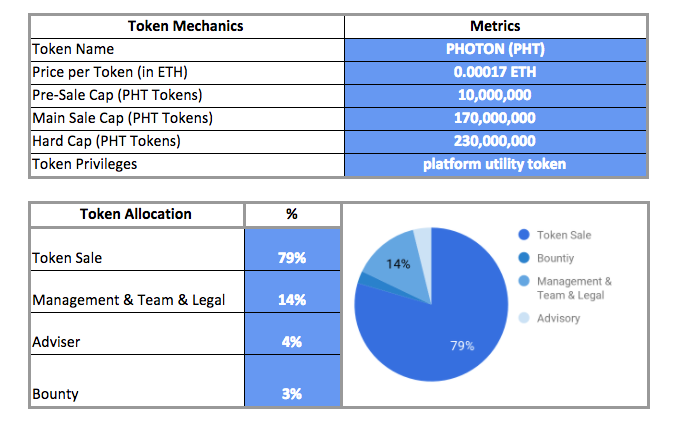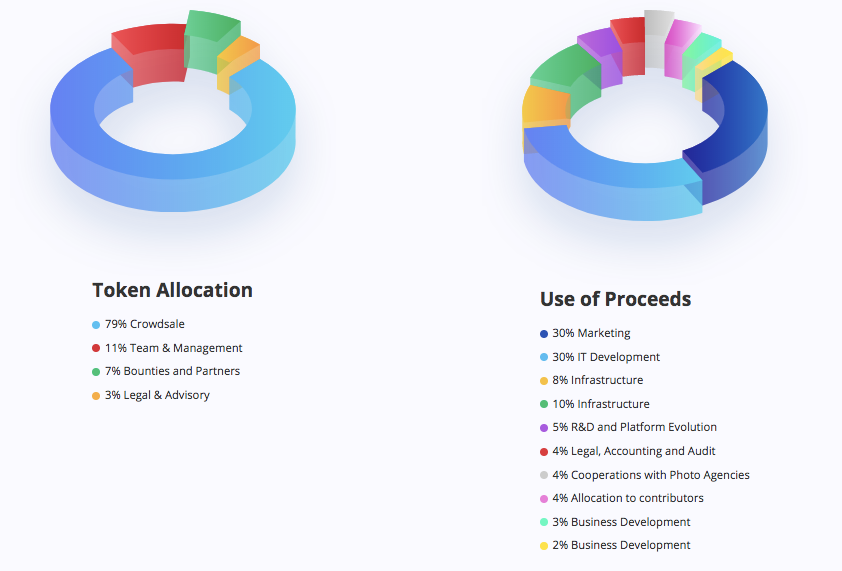
Photochain PHT aims to use blockchain to revolutionize stock photography. Find out how Photochain works today in our review.
Photochain revolutionizes the status quo of stock photography. It is a decentralized, peer-to-peer stock photography platform on blockchain with fair conditions, attractive incentivation mechanisms, lowest fees in the market and full control over the content, price and license type for the photographer. On the IPFS Photochain database, each uploaded photo is linked to a photographer through a blockchain transaction. This link cannot be removed or manipulated in any way. Photochain is in the pole position and ready to disrupt the monopolized stock photography industry with a great, experienced and influential team and board of advisors.
What Is Photochain?
Photochain, found online at Photochain.io, uses blockchain technology “to reinvent photostocks around the buyers and the sellers,” explains the official website.
The goal is to pay photographers more for their work than they currently earn on centralized stock photography platforms. The Photochain website claims that many popular stock photography platforms pay photographers just 23% of the final price for their work. In comparison, Photochain wants to pay photographers 95%.
Photochain also emphasizes a fast verification period and fast payment times. Plus, photographers will be able to set their own prices.
Photochain is being developed by an Estonia-based team. The token sale for the platform’s PHOTON tokens, or PHTs, will be held in April 2018.
Photochain’s Mission
Photochain gives clear advantages over conventional photo stocks to both kinds of users: contributors and customers. Contributors at Photochain benefit from an extremely low fee – only 5% of the selling price.
This opportunity to keep 95% of the final sale price allows contributors to offer their work cheaper, and consequently the market becomes more affordable for customers. This type of fair market not only benefits the users, but should benefit the photography industry as a whole, as the possibility of increased income incentivizes contributors to perform better.
These profound market changes are only made possible by using blockchain technology, Smart Contracts, machine learning and Photochain’s own user community. Most of the processes become automated and decentralized, significantly reducing costs of platform governance.
How Does Photochain Work?
Photochain is built as a native blockchain decentralized app (dApp) on the Ethereum network. The app uses InterPlanetary File System (IPFS) to secure data across the network.
The Photochain dApp emphasizes four core features and functions, including:
Security:
Photochain provides blockchain-based security for buyers and sellers so “you can trust your works are safe.”
Decentralized:
Digital content is encrypted and stored on the decentralized database. No central business controls your uploaded photography.
Copyright:
Your work is permanently linked to your identity through the blockchain, creating a new blockchain-based form of copyright protection.
Content:
The decentralized app can be used exclusively for trading photography. Photochain will sue bots “to ensure only acceptable content is listed.”
One of the core benefits of Photochain is its copyrighting system. They call it Photochain Digital Copyright Chain, or DCC. Artists can link their works to their name, then secure that connection using the blockchain. The Ethereum blockchain secures the transaction, making it visible to users at all times. Anyone can check the Ethereum blockchain to verify that content is copyrighted by a particular person.
Photochain sees their copyright system as superior to “Rights Managed” (RM) copyrighting models as well as “Royalty Free” (RF) copyright models.
Photochain will also have a P2P marketplace where artists can freely distribute their work. Artists can charge different amounts to different buyers. They set their own prices.
Finally, Photochain will also have a ranking system and a reward system to serve as motivation, ensuring the maintenance of the Photochain community through fair rewards. Sellers receive points for selling works, for example, and moderators get points for solving disputes. Each point is equivalent to 0.1 PHT. Once you hit 100 points, you can get a payout in PHT transferred to your wallet address.
Photochain Fees
Photochain will charge a 5% fee. This fee goes to the wallet of the Photochain Governance account.
If a photo is priced at 5 EUR, then a fee of 25 cents will be added. The 5% fee is divided into different components of the app, with most of it going to the team and the app reserve fund:
- 0.02% for the Ethereum network fee paid to miners and for interaction with the Photochain smart contract
- 0.98% for data storage costs, because pictures and digital works require ample storage space
- 2% for the Photochain Governance Team for ongoing development and moderation
- 2% for the Photochain decentralized app (DApp) reserve
The Photochain DApp reserve fund will be used to pay rewards for resolving disputes. Higher payouts from this fund will need approval from two moderators of the highest level, while smaller payouts (like rewards for resolving a claim) can be processed automatically.
The Photochain whitepaper also mentions the possibility of charging 10% fees and 15% fees for Silver and Gold accounts. They have three different models of transaction fees in total. Users can pay higher fees based on the level of service they wish to get from the platform.
Features of PhotoChain
Photochain offers all of the following features:
Claim Module:
Users can use the Claim Module to act against copyright infringements. If a piece of content is suspected of infringing upon copyright, then users can use the Claim Module.
Claims will be processed based on whether or not the image is the same as the one posted on the Photochain DApp, and whether or not the author’s name is attached to that image according to the blockchain.
Photochain’s machine learning mechanisms will analyze whether these requirements are fulfilled, then issue compensation. Larger compensation will require the input of moderators.
Seller Module:
The seller module gives sellers a simple way to offer pieces for sale on the Photochain app.
Content Upload Module:
If you decide to sell a piece on the Photochain app, then you’ll upload photos through the Content Upload Module. After upload, your files will be stored on the IPFS network.
Content Verification Module:
This module verifies whether or not your copyrights are infringed upon or if the content contains illegal materials. The module uses the IPFS Photochain node to accomplish this.
Buyer Module:
Buyers can use this module to easily search for photos available to purchase. The Buyer Module includes contextual searches using tags, searching of similar images, and more.
Payment Wallet Module:
The payment wallet module has access to the Photochain user’s Ethereum address.
Transaction Data Module:
The transaction data module processes transactions.
Overall, Photochain emphasizes high availability, decentralized use, structured data storage, data erasure, and speed.
Photochain Platform
With all currently existing stock photography platforms, the only way that security in transactions can be ensured is via central control. Compared to that, we are creating a platform that works autonomously, securely and efficiently based on predefined rules.
We are developing the Photochain DApp on the Ethereum blockchain. Additionally, Photochain also uses computer vision (machine learning) to fulfil the specific technological requirements of stock photography.
The Photochain DApp is a platform on which artists have the opportunity to sell their work to a broad audience at a price they set themselves, and where sellers are also fully and solely liable for the works they sell themselves. The Photochain Team does not have any liability or responsibility for illegal behaviour from the sellers.
This means that the artist is responsible for the legality of the works he is selling, and is held fully accountable for any illegal activity. Photochain however, will uphold users copyright protection, by preventing unauthorised sale of photography.
The Photochain Token Sale
Photochain tokens, or PHOTONs or PHTs, are ERC20 tokens on the Ethereum blockchain.
There’s a hard cap of 230 million PHT tokens available to be issued. Of the total supply of tokens, 79% are allocated to token sales. The remaining tokens are reserved for the management, the team, and legal expenses (14%), advisors (4%), and bounties (3%).
The pre-sale began all the way back in January 2017.

The main token sale, meanwhile, is scheduled for April 6. The whitepaper lists the token sale as lasting just one day: from 06.04.2018 at 8am CET to 06.04.2018 at 12am CET.
I don’t fully understand what that means. Based on the listed dates and times, the token sale is scheduled to end before it begins (at midnight the day before). Hopefully Photochain will provide clarity on their token sale times. It seems unusual for a token sale to last just one day.

Who’s Behind Photochain PHT?
Photochain was co-founded by Stanislav Stolberg (CEO) and Arthur Ishmetev (CTO). Stolberg is an InfoSec consultant and “digital transformation manager” while Ishmetev is a software architect and full stack developer.
The company is based in Tallinn, Estonia.
Photochain PHT ICO Conclusion
Photochain aims to create a better stock photography environment using blockchain technology. The platform will introduce innovations like the Photochain Digital Copyright Chain, or DCC, which will attach photo ownership information to a specific user, then post information to the Ethereum blockchain.
TEAM



ADVISORS


Roadmap
Contacts
The developers can be contacted using the link below:
ETH Address : 0x4be0D62Fc296136326F1A6BB6E3A543472c41820
0 Response to "Photochain (PHT) - The Stock Photography Revolution (ICO REVIEW)"
Post a Comment